Volunteer Newsletter / October 2025
Improvements to the Volunteer membership program!
One benefit for our volunteers has been individual Volunteer Membership Cards to people who volunteer at least 40 hours of work in the past fiscal year (April 1-March 31). The membership cards were given out at the volunteer appreciation event at the end of the summer for the previous year’s contributions. This lag time between your volunteer hours and an appreciation from VINS seemed unnecessarily long so we are adjusting the program. We now collect volunteer hours contributed quarterly and will gift the individual VINS annual membership cards at the start of April, July, October and January for volunteers who met the 40 hour requirement. If you have contributed over 40 hours since April 1, please email Erica, etucker@vinsweb.org, so we can award you a one-year volunteer membership. We will still collect your timesheet with total hours contributed at the end of the fiscal year (Mar 31, 2026). Thank you!
Change of season means change of hours and program times!
On November 1 we begin our winter hours and are open from 10-4 daily (we are closed on Thanksgiving Day and Christmas). Our winter program schedule as of November 1 is:
- 10:30am – Natural Wonders
- 11:00am – Raptors Up Close
- 12:30pm – Songbird Aviary Tour
- 2:00pm – Raptor Feeding Time
Volunteers needed for Hoots & Howls on Saturday October 25th
This annual event features an evening of fun with storytellers, performers, music, and of course some tricky treats. It’s always a delightful event, especially with the amazing costumes that everyone creates!
To make the event possible and fun for visitors, we will need some extra help during the evening. If you are interested and available to help out, reach out to Mya with your preferences and I will add you to our list and give you any additional details about the evening that you will need. mwiles@vinsweb.org
Greeting: (1-2 needed) Gather and meet guests at the tour starting point in the August Pavilion to get them oriented. Each group needs to depart with their guides at the right time and with all of the members of that group in attendance.
Tour Guide: (at least 5 needed) Gather at the August Pavilion to meet your group and lead them across campus, making sure your group is arriving and leaving each station on time. There will be 12 tours throughout the evening, departing every 10 minutes starting at 5:30pm. The last tour ends at 8:00pm.
Treat Guard: (2-3needed) Monitor the Neale Pavilion’s supply of snacks and engage with visitors as they finish their tour before heading up the hill and departing.
Volunteers needed for Forest of Lights 2025-2026!
We are in need of volunteers to help us cover these wonderful evening events that run for 26 nights. It is a fun family event with up to 500 people attending each night!
We will provide each volunteer with 2 complimentary tickets for each night you work. These tickets can be turned in at the entrance for any night of the event after your service!
You will be helping with the general guest experience, campfire, refreshments and/or taking photos of guests out on the Forest Canopy Walk. Youth volunteers accompanied by an adult are welcome!
A Forest of Lights will run on the following evenings:
- Nov 21, 22, 28, 29, 30
- Dec 4, 5, 6, 11, 12, 13, 18, 19, 20, 21, 22, 23, 26, 27, 28, 29, 30, 31
- Jan 1, 2, 3
Volunteer Shift: 3:30-7:30 PM
Please respond to Chris Collier with your availability: ccollier@vinsweb.org
Volunteer Spotlight: Aine
My name is Aine, and I have been volunteering at VINS since I was six. In those seven years, I have worked in all three branches of VINS (education, research, and avian wildlife rehabilitation) and my favorite job so far has been catching monarch butterflies in research. This involves looking in stands of good-smelling goldenrod. VINS mostly specializes in birds, but there are all kinds of animals involved with research, most of them wild.
Monarch butterflies migrate each year from the northern United States and southern Canada all the way to Mexico. In the late summer and autumn, when they are starting their journeys, I catch them with a net. Then I put a tiny tag on the wing, and release the butterfly. The tags let humans find out how many butterflies reach Mexico. When I catch monarchs, I first have to find them. I look through the goldenrod and butterfly weed, and look in the air, too. Last week, I saw a monarch and went close to him. He flew ten feet before landing. He did this several times before I dropped my net over him. I have liked all my volunteer positions, but catching butterflies is my favorite.
Exhibit Raptor Highlight
I’ve been having trouble deciding which bird to highlight – every time I decide on one, another pops up in my head and begs me to talk about them. It’s hard when all of our birds are this interesting and charismatic! At least for now we’ll take some time to talk about our resident southern belle, Los Angeles; in the future if you have specific birds that you want highlighted for additional background info or fun facts, please let me know.
Los Angeles (a.k.a. LA) was found originally in Georgia… I know, “since when is Los Angeles a city in Georgia, Spencer?” While LA is originally from Georgia, when she was first injured she was transferred to the California Wildlife Center in, you guessed it, Calabasas. Calabasas is in Los Angeles County, so that must be where the name came from! When she was at the rehab center in CA her name was Baby; I’m glad that name didn’t stick around for very long.
LA has been with VINS for 7 years now, and has been on exhibit for 5 of those years. She is with us because her right eye was enucleated due to severe glaucoma (i.e. a fancy way to say they removed her eye). In addition to the enucleation, her left eye has a cataract that covers about 40% of the eye’s surface area; all of these vision defects leave her with possibly only 20% of her original vision. In terms of care for a bird with reduced vision such as her, it is important that they have an enclosure that is easy to navigate. For LA, since she is prone to hopping up suddenly and flying around, or running around on the ground, that means a relatively open enclosure with minimal obstructions for her to bump into. Ever since she moved to her new enclosure this past spring, I’ve noticed that she spends the majority of her time up on the perch above the tree. She seems to enjoy it up there!
I wanted to highlight LA for this newsletter because she is a wonderfully friendly bird, and has gone through some basic training over the years with our education team that left her with a couple useful husbandry skills. Usually when we want a weight for one of our birds on exhibit we have to catch them up in a net, bundle them up like a burrito, and weigh them on a large scale just like a baby. This is understandably stressful for the birds! When a bird is willing to step onto a scale of their own volition, then we have a much easier and noninvasive way of obtaining important health information. See the pictures below for LA sitting on the scale.
Time for some fun facts about Black Vultures! The first important thing to know is that they are usually a warmer climate species than Vermont, which is why LA returns to indoor enclosures for the winter time to keep nice and warm. Historically, the range for Black Vultures has been (almost all) of South America, all the way north to about Delaware/Pennsylvania on the East Coast – while avoiding the West Coast entirely. In recent years there have been nesting pairs sighted in northern Vermont, and it seems that they stick around all year round. Just another example of how human impact is changing the geography of animals!
Black Vultures rely on their eyesight for finding their next meal, as their sense of smell isn’t as developed as Turkey Vultures. We all know that Turkey Vultures have an excellent nose that allows them to scent out meat from more than a mile away, but Black Vultures have something even better. Wits! Instead of wasting time trying to find their own food, they follow groups of Turkey Vultures down to their meals and steal away that hard earned meat.
If you have any further questions about our resident Black Vulture, feel free to email me or track me down in person.
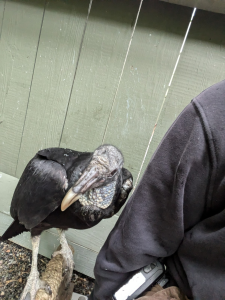

Exhibit Species Updates
Hello everyone! Since our last newsletter went out there have not been that many changes to the exhibit bird numbers, but nonetheless there are still some enclosure swaps and other shenanigans going on as we move towards winter.
The main move that happens every year is that our Broad-winged Hawks and our lovely spotlighted lady Los Angeles will be moving to their winter homes in the education mews (which are temperature controlled through the colder months). In their place, we will receive Bridport, our Rough-legged Hawk, and Windham, our female Cooper’s Hawk to be our winter ambassadors in the raptor exhibits.
This change will not occur until Wednesday, Nov. 5th when all of the education birds undergo their annual fall health checks. When the time comes, I will send out a detailed email with some information about the new enclosure swaps, including some information to highlight for guests when they ask questions, or for my P.M. volunteers who do the raptor feeding shows.
In the meantime, for those of you who have missed my occasional email about the Northern Harriers, we are continuing to try to find a permanent solution for their enclosure. With various tarps and extra perches, we are hoping that the enclosure changes will ensure Addison’s continued comfort and safety. If you notice any changes in behavior or have any other notes, feel free to reach out to me. It is likely that we will end up giving them a completely solid roof, and possibly also adding mesh onto the ceiling to prevent Addison from bonking her head. It all depends on what we see during our test trials in the coming weeks.
That’s all for raptors.
Songbirds! Since the last newsletter we have lost a couple birds and also gained a couple, so I will put a complete list here (any additions are italicized, and any losses are strike[d?]through). The biggest news is unfortunately quite sad. Our oldest resident songbird, Wilder, passed away at the end of September. She left exhibit at the beginning of the spring to avoid the springtime aggression of the other cardinals. We returned her in mid September with a new boy in tow, and after a little bit of a rocky start back into the aviary with some posturing and some chasing, the four cardinals figured out a peaceful situation. Unfortunately, she was found this past Sunday morning with limited mobility, and died overnight in CWBR. She lived to be 13 years old, which is an impressively long time for a cardinal! The oldest cardinal ever found in the wild was 15 years old, but the average is only 3 years.
Songbirds – total 35:
- 4 Blue Jays – Bennington, White River Junction, Quechee, & Grafton
- 7 Robins – Piermont, Strafford, Hanover, Barre, Plainfield, Montpelier, & Middlebury
- 1 Tree Sparrow – Essex
- 2 White-throated Sparrow – Danville & West Bradford
- 1 Song Sparrow – Etna
- 2 Purple Finches – College & Killington
- 1 House Finch – Christian
- 1 Eastern Bluebird – Canaan
- 5 Cedar Waxwings – Main, Vermont, Gorham, Fay Brook, & Occom
- 3 Northern Cardinals – Rutland, Lisbon,
Wilder,& Reservoir - 2 American Goldfinches –
West,Newbury, & Hazen - 5 Mourning Doves – Washington, Plymouth, Windsor, Crafts, & Bethel
- 0 Pine Grosbeaks –
Bradford
Center for Wild Bird Rehabilitation
By the Numbers – Intakes & Total Patient Counts
As of today (9/19) we are averaging about 3 intakes/day for September. A significant decrease from the last few months. So far we have received 1,086 patients in 2025, and we currently have 74 birds in care. As far as species, we’ve been getting a shockingly high number of broad-winged hawks. It’s pretty typical for us to see high numbers in August, but we’ve been getting them regularly well into September. We’ve also seen a decrease in baby admissions. Otherwise, kind of a mixed bag due to fall migration!
Interesting Patients/News
Oddly enough we currently have 3 Great Horned Owls in care. I (Celia) haven’t been here too long, but I don’t remember us ever having more than one at any given time, if at all. And one of them is a GIGANTIC female. She came in weighing 1,656g! The average weight for a Great Horned Owl is 1,400g according to our Sibley guide.
Rehab Fact
We tend to have a good amount of patients suspected to have West Nile Virus (WNV) come into care around late summer. It is a virus that is spread by mosquitoes, and can cause some birds to be symptomatic. To truly diagnose you would need to run a test that detects WNV antibodies in the blood. We don’t have that type of testing readily available to us, so we are often looking at symptoms for a diagnosis. Is the bird neurologic or depressed? Are there digestive issues? Abnormal feather pinching (dropping feathers that appear to be pinched off at the ends instead of molted naturally)? Some of these symptoms can apply to many different infections/injuries, but the combination can be a good indicator that a bird has WNV.
Summer 2025 Busy Season Wrap-up
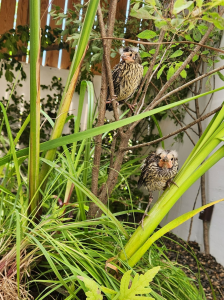
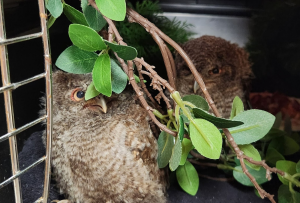
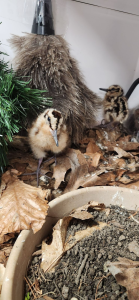

Now that the 2025 baby bird season has officially wrapped up, I wanted to send out a review of intakes for the busy season in 2025 (May 1st – September 15th). But first, I and the rehab team would like to extend a huge thank you to our baby bird feeding, rehab and transport volunteers for all of your help this summer! We truly couldn’t do what we do without your help! Each day we had roughly 6-8 volunteers helping us out, probably around 2,800 hours of assistance throughout the busy season, not including driving time for transports.
- Total intakes: 916
- Total species: 90
- Top 5 species:
- American Robin: 96
- Eastern Phoebe: 54
- Broad-winged Hawk: 51
- European Starling: 50
- American Crow: 37
- Total babies: 502
- Total baby species: 55
Top 5 baby bird species:
- American Robin: 75
- Eastern Phoebe: 49
- European Starling: 35
- House Sparrow: 31
- Common Grackle: 21
Some highlight and unusual patients (at least for me), included a pair of fledgling screech owls, red-winged blackbird nestlings (which we’ve never raised before), and my longtime favorite babies American robins and the ever-polarizing chimney swifts.
Again, a huge, huge thank you to all of our volunteers who helped make the release of all of these birds possible!
Education Ambassadors
Training Milestones
Ever wonder how long it takes for a wild raptor to become a comfortable ambassador for their species? It depends! But for our young Red-tailed Hawk Sharon, she is still making strides to becoming a confident ambassador, but has been doing exceptionally well this summer. In particular, she has been hopping into her crate with confidence regularly, even when she is backstage in the Neale Pavilion or HawkFly, and has made appearances during a few quiet indoor programs so far this year. While she can still be a bit nervous around large, mobile audiences, especially in the HawkFly, she has made a lot of progress so far this summer and will hopefully continue to progress through the winter.
Highlighted Ambassador
Miami (Eastern Screech Owl)
Miami was transferred to VINS in 2017 after sustaining a head injury that left him blind in his right eye. He was a nestling in the cavity of a tree that was cut down, so he and his siblings were brought to a rehabilitation facility in Miami, FL where they were treated and cared for until they were ready to be released. But due to his head/eye injury, Miami was deemed non-releaseable. Now, he is a star in any program he attends, amazing visitors with his size and camouflage, reminding them that there is wildlife all around us, even if we can’t see them!
Raptor Fact
Eagles, hawks, falcons, owls, and sometimes vultures. Birds of prey– also commonly called raptors, are a familiar group of birds to us here at VINS, but what IS a raptor?
Taxonomically, the list that we usually provide guests at the start of our programs is actually a few distinct groups of birds. Falcons for example are not at all related to any other ‘raptor’ and are most closely related to parrots. Hawks and eagles are often listed as distinct from one another but the true distinction between these birds is actually quite arbitrary as they are all in the same family: Accipitridae, alongside the vultures of the eastern hemisphere.
If they’re not related to one another by evolution, then why group them together at all? Well, generally raptors are defined by their similar morphology and ecology. Sharp curved beak, strong grasping talons, and large keen eyes for spotting prey, all to help with an active hunting lifestyle. Unfortunately even that definition doesn’t cover all ‘raptors’. For example, most vultures are adapted for a scavenging life history and have lost the strong grasping talons of their cousins in favor of a strong beak and neck for tearing into carcasses. It gets a bit into the weeds once you really look into it, but for conservation purposes it can be helpful to have a name to refer to a broad group of animals so that it is easier to market their protection in the wild. By generalizing a category of animals, more species can fall within the boundaries of protection under laws and grants gained to protect the whole group.
So while it is our human tendency to try and put things in boxes that perhaps do not truly fit, it does make communicating about these animals easier, and therefore easier to learn about and connect with them.
Ask the Trainers
What are those things on the bird’s feet/legs?
When handling the glove ambassador birds during programs and outreaches you may notice bits of leather, cord, and metal clips adorning the glove and the bird’s legs. These things are broadly referred to as their equipment, which act primarily as a safety tool for the bird while outdoors. Just like you may walk your dog down a busy path or road using a collar and leash, the birds have anklets, jesses, and a leash to make sure they are safe while outside of their enclosures. The anklets fit around the lower part of the bird’s leg just above the toes and have a brass eyelet affixed at the back, allowing the jess, a long strip of leather with a knot at one end, to pass through. Most of the ambassador birds wear both anklets and jesses all the time, but a few ambassadors have removable jesses that can be put on as needed. The leash is attached to the end of the jesses at one side using a swivelling clip, and then attached to the glove at the other end with another clasp. This system ensures that even if the bird gets spooked by something while out on glove, they will not be able to harm themselves or get stuck somewhere dangerous by accident because they cannot fly/fall far from the glove, giving the handler control over where they go before promptly moving them away from the scary stimulus. Note that the equipment is not used to restrain the bird’s feet to the glove, or to grab them from a perch, and is only used as a safety tool.
Finally, the history of raptor handling equipment is quite long, as it has evolved over thousands of years from the original peoples who practiced falconry, all the way to modern-day falconers. So, many variations on this system have been used in different ways, but this is the current system that has worked best for us here at VINS!
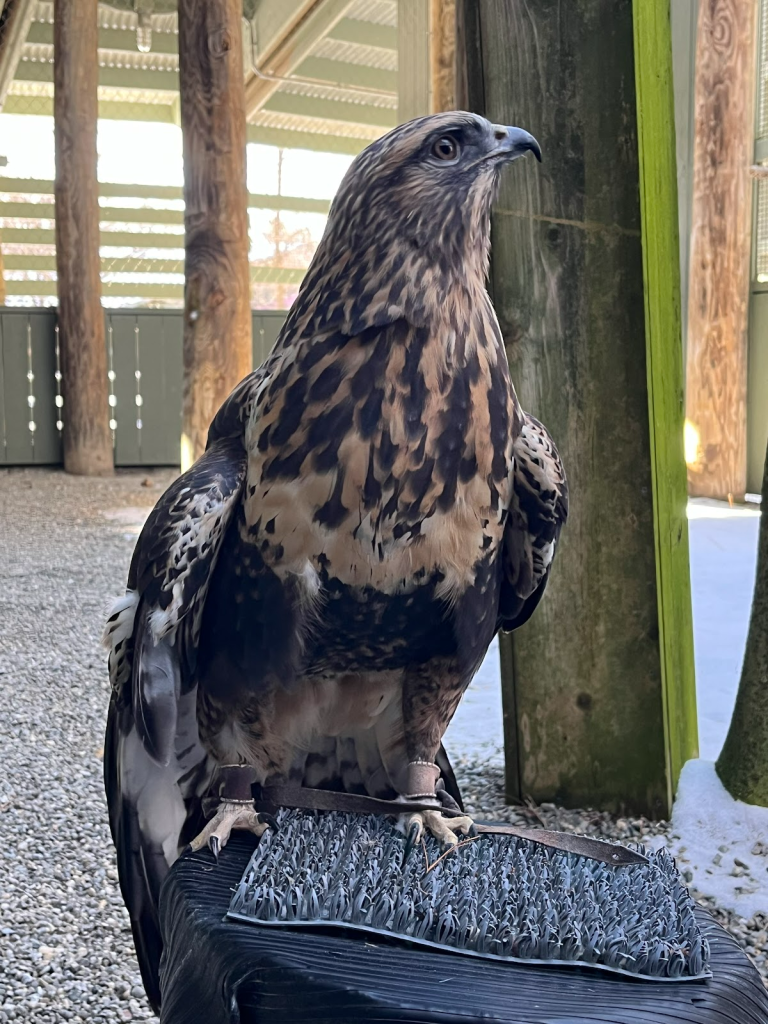
If you have any specific questions about training, let us know and we can answer your questions in the next newsletter! Feel free to forward questions to Mya at mwiles@vinsweb.org or Anna at amorris@vinsweb.org.

Excellent newsletter. Thanks!
a question I posed before: do the raptors recognize people who “work” with them, whether training, or feeding, or scrapping? and how do we know that they do recognize them, if they do?
I always enjoy receiving the newsletter. Thank you!